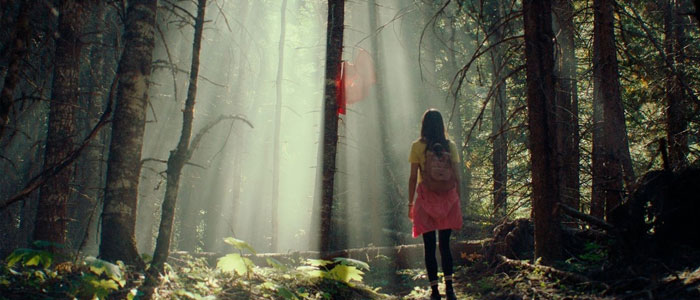KRYPTIC
*½/****
starring Chloe Pirrie, Jeff Gladstone, Jason Deline, Ali Rusu-Tahir
written by Paul Bromley
directed by Kourtney Roy
THE BEAST WITHIN
*/****
starring James Cosmo, Ashleigh Cummings, Kit Harington, Caoilinn Springall
written by Greer Ellison & Alexander J. Farrell
directed by Alexander J. Farrell
VULCANIZADORA
***½/****
starring Melissa Blanchard, Joshua Burge, Joel Potrykus, Solo Potrykus
written and directed by Joel Potrykus
ANIMALIA PARADOXA
****/****
starring Andrea Gomez, Daniela Ossa, Javiera Reyes, Hormazábal Rocío
written and directed by Niles Atallah
by Walter Chaw The problem with Kourtney Roy’s Kryptic is that its subtext is text. It’s well-shot, well-performed, even has some nice Yuzna-esque goop effects, but it’s so didactic that all that hardly matters. When the message becomes exposition, it indicates a lack of faith in both the audience and the material. I’m as tired of writing about this as you are of reading about it, I’m sure, and I must confess it takes a lot out of me nowadays to finish films like this, however well-made and however promising its director might be, should they ever get out of their own way. Kryptic would be less frustrating if it weren’t so good in so many ways. It opens with shy, socially anxious Kay (Chloe Pirrie) on her drive to a guided cryptid hike, repeating positive affirmations to buck herself up for meeting new people and maybe making new friends. In the woods, she strays from the group and encounters the terrifying Sooka (glimpsed only in flashes), sending her into a fugue state wherein she forgets who she is and what she does. “I’m a dentist?” she asks. “I’m a veterinarian?” Most likely, she’s a cryptozoologist named “Barb” who has been missing in these woods for some time. Also likely is that Barb went missing because she was fleeing her abusive husband, Morgan (Jeff Gladstone).
Kryptic makes metaphor out of post-traumatic stress responses, a The Shining out of “Little Red Riding Hood”–and indeed, it’s Shelley Duvall (with a disarming dash of Sissy Spacek) whom Pirrie most resembles in demeanour and performance, while the arc of her character brings the eponymous May of Lucky McKee’s film to mind: another haunted young woman driven into her interiors to confront wolves in a loved one’s clothes. The tone of Kryptic initially is that of a mannered indie Parker Posey comedy punctuated by flashes of slime and tentacles swallowing Kay or belching up the faces of people she meets along her journey of self-discovery. She returns eventually to Barb’s house, robbing herself of her voice as Morgan welcomes her in and almost immediately starts grooming her to be pathologically controlled and humiliated. But Kay/Barb is ready for him this time and well and truly comes into her power, shedding her “skin” and donning a red hood. And what does the fairytale-structured hunt for a mythical creature that has the power over mind, space, time, and identity have to do with it? It’s the type of question that provides the answer. If you ask me, broad metaphors for real atrocities are unstable and explosive. Is equating a broken woman to a cryptid really the right thing? Worse, is it striking the right tone to compare a broken woman who discovers her voice to a cryptid? Or is it that the search for actualization is like going on a snipe hunt?
Alexander J. Farrell’s The Beast Within (no relation to the Philippe Mora film of the same name) is the male version of Kryptic, a watered-down version of The Company of Wolves that finds brusque, burly Noah (Kit Harrington), patriarch of a small, struggling family, cursed with the misfortune of turning into a wolf when the moon is full. The original curse from George Waggner’s The Wolf Man warns, “Even a man who is pure of heart and says his prayers by night may become a wolf when the wolfbane blooms and the autumn moon is bright,” locating a metaphor for the innate violence of men and the mysterious triggers that might unleash it. The problem with The Beast Within–which, like Kryptic, is beautifully shot and exquisitely performed–is that it’s somehow even more obvious about a message that doesn’t inspire much controversy. Men shouldn’t beat their wives and children? Agreed. Noah is a horrific domestic abuser, a fact his young daughter Willow (Caoilinn Springall, exceptional), stricken with a breathing problem, comes to learn not only from spying strange bruises all over the body of her mother Imogen (Ashleigh Cummings) but also from Noah, who gets chained up at night, occasionally slapping sandwiches out of her hands for no reason before dancing like a scary ape. There’s never any doubt that his alleged lycanthropy is a euphemism for Daddy going mad every single time he’s not literally in chains. There are so many issues in orbit around domestic violence–the danger of staying, the danger of running, the way violence might pass on generationally–that are portrayed without due consideration, and the tension of whether Willow will finally die from an asthma attack begins to feel more like exploitation than like thoughtful exploration.
Much better is Joel Potrykus’s oblique and sometimes frustrating but always fruitfully challenging Vulcanizadora. It also takes place in the wilderness but doesn’t empty its basement to furnish its living room. In other words, it keeps its subtext as subtext. The text concerns two buddies, taciturn Martin (Joshua Burge) and blabbermouth Derek (Potrykus), going off-trail with the aimless goal of filming a potentially viral clip of Derek getting hit full in the face with a Roman candle. Martin is delaying a prison term, while Derek is divorced with a kid and ex-wife who hate him because he’s a shiftless dreamer given to get-rich-quick schemes–like, for instance, reviving the infamous “Faces of Death” VHS series, the holy grail for an entire generation of kids gawking at its cover in mom-and-pop video stores. Alas, Martin’s timing is as bad as his aim with a Roman candle, and their relationship proceeds for the first half of the movie as manic monologuing against irritated silence (a bit like that of assassins Grimsrud and Carl in the Coen Brothers’ Fargo), up to a moment of shocking violence that happens because they’re desperate idiots, yet feels like it happens because their friendship is based on their being the only ones who can stand each other, and just barely at that. I was immediately struck by Vulcanizadora‘s similarity to Gus Van Sant’s Gerry: it’s more reliant on the percussion created by the characters’ steady gait and the cadence of dialogue that works as a musical counterpoint to it than on the substance of either. It could be in any language and the meaning wouldn’t be lost. Martin and Derek are random tea particles engaged in Brownian motion, cutting across the wild in a God’s-eye view. And just as we’re settling into the rhythm of a stoner hangout flick, a Terrible Thing happens.
Vulcanizadora is about owning up to one’s shortcomings and coming to terms with the cold reality that there is no one who can help us–or, at least, no one who will. Fascinatingly, it’s also about understanding the sequence of choices that lead us to moments of crisis. At one point, Martin says he’s an inherently “guilty dude,” and though presented as a laugh line, a throwaway, it touches on a Catholic maxim of the inescapable pervasiveness of sin. Is Martin destined to be guilty? Is Derek destined to disappoint his family? And what is Derek’s little boy (Solo Potrykus) destined to be? Can we tell if Potrykus’s son will be an actor from the few minutes he’s on screen? We can at least tell that his dad knows how to use him for maximum effect as he reads, in his halting, five-year-old way, a note his absent father has allegedly written to him, apologizing for his absence. Redemption emerges as a theme: the possibility that constructing a new story for someone might change the fates of everyone who believes it. Storytelling as the Word. Potrykus has said the film’s title is the name of a tire shop near his house that he thought sounded beautiful. I love how this idiosyncratic exercise makes sense to us without exposition. It is the distillation of the ineffable. It offers up remorse, desire for reparation, and need for atonement most of all in ways that require our participation; our empathy and experience give the movie meaning, and Vulcanizadora trusts us to meet it halfway. Its final images of a tripod washing up on a beach where Martin has returned either to expose his culpability in a crime or to drown himself in the ocean (maybe both), reminded me of the last “image” from Thomas Mann’s Death in Venice. There, an unmanned camera, its hood fluttering in the wind, holds within it the ephemeral nature of desire, the loss of agency in the death of the narrator, and finally, the idea of how little we can ever capture through the limited scope of our perception.
All of this hints at the pleasures of Niles Atallah’s Animalia Paradoxa, a film named after a heading in the first five editions of Carl Linnaeus’s Systema Naturae that includes mythological creatures, cryptids, legends that fall outside of the biologist’s taxonomic classification system. Unicorns, satyrs, hydras, dragons–animals pulled from tall tales told by travellers, early histories, and other disreputable and eventually debunked sources. Atallah’s film is about a possibly amphibious humanoid (Andrea Gómez), its movements interpretive dance and its features obscured by a gasmask, skullcap, milky contacts, and green makeup. It lives in an apocalyptic wasteland, where we watch it engage in a series of transactions, the goal of which for our hero seems to be to get enough liquid to fill a giant concrete pool so that it can “return” to an ocean we are told no longer exists. Given that the news of the death of Earth’s waters comes from a cult-leader terrorizing survivors huddled in a crumbling tenement, it’s hard to know whether it’s real or referring to a spiritual death. Does the “ocean” that is gone represent a collective unconscious that once bound living things with common signs but no longer does? The notes from Fantastic Fest for the movie reference Lucian Freud and Jean Painleve. Scholar Kier-La Janisse adds Steven Arnold and Jodorowsky. I would insert E. Elias Merhige’s Begotten and Sergei Parajanov’s sublime The Color of Pomegranates as well.
Animalia Paradoxa contains enough multitudes to absorb these comparisons and more. It mixes film stocks and archival footage along with stop-motion animation in the style of its production company’s searing La casa lobo–all in the pursuit of representing feelings of yearning and disconnection, our numberless days of rote toil to fill time that is simultaneously too brief and interminable. It’s a gorgeous picture and a horrific one, and it doesn’t offer up its secrets unless you’re ready to engage it on a sensual level. I thought of Matthew Barney’s Cremaster Cycle, too, and how it told the secret history of the Masons through images sacred and profane. Animalia Paradoxa, like Linnaeus’s guidebook, is a taxonomy of hints and rumours created to explain the inexplicable, to give shape and movement, flesh and breath, to our fears for our future. We will change, and the world will change with us. What will we retain, should we survive? Who will mourn if we don’t? What stories will we conjure–and how will we tell them–to ease our passage into night?






